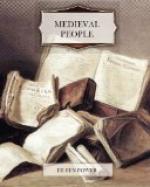Such a familiar figure was once old Thomas Paycocke, clothier, of Coggeshall in Essex, who died full of years and honour in 1518. His family originally came from Clare, in Suffolk, but about the middle of the fifteenth century a branch settled at Coggeshall, a village not far distant. His grandfather and father would seem to have been grazing butchers, but he and his brother and their descendants after them followed ‘the truly noble manufacture’ of cloth-making, and set an indelible mark upon the village where they dwelt. Coggeshall lies in the great cloth-making district of Essex, of which Fuller wrote: ’This county is charactered like Bethsheba, “She layeth her hand to the spindle and her hands hold the distaffe."... It will not be amiss to pray that the plough may go along and the wheel around, that so (being fed by the one and clothed by the other) there may be, by God’s blessing, no danger of starving in our nation[2] All over Essex there lay villages famous for cloth-making, Coggeshall and Braintree, Bocking and Halstead, Shalford and Dedham, and above all Colchester, the great centre and mart of the trade. The villages throve on the industry and there was hardly a cottage which did not hum with the spinning wheel, and hardly a street where you might not have counted weavers’ workshops, kitchens where the rough loom stood by the wall to occupy the goodman’s working hours. Hardly a week but the clatter of the pack-horse would be heard in the straggling streets, bringing in new stores of wool to be worked and taking away the pieces of cloth to the clothiers of Colchester and the surrounding




